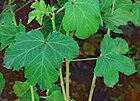Note: This is a project under development. The articles on this wiki are just being initiated and broadly incomplete. You can Help creating new pages.
Abelmoschus esculentus - Bhenda, ಬೆಂಡೆಕಾಯಿ, भिंडी, வெண்டி/பெண் விரல், ലേഡിഫിംഗർ, भेंडी
Okra is an annual plant growing about 1.5 metres tall. The plant is widely cultivated in warm temperate to tropical areas for its edible seedpods. It has various other edible and medicinal uses as well as being the source of a good fibre.
Contents
- 1 Uses
- 2 Parts Used
- 3 Chemical Composition
- 4 Common names
- 5 Properties
- 6 Habit
- 7 Identification
- 8 List of Ayurvedic medicine in which the herb is used
- 9 Where to get the saplings
- 10 Mode of Propagation
- 11 How to plant/cultivate
- 12 Commonly seen growing in areas
- 13 Photo Gallery
- 14 References
- 15 External Links
Uses
Digestive problems, Syphilis, Cuts, Wounds, Boils, Dysuria, Skin problems, Ardor urinae, Gonorrhoea, Dandruff. [1]
Parts Used
Chemical Composition
The ripe fruits contain quercetin, hyperin (hyperoside), hydrolysate of precipitated mucilage, proanthocyanidins, D-glucose, D-glucuronic and galacturonic acids. Fresh flowers contain flavonol glycosides and anthocyanins. [2]
Common names
| Language | Common name |
|---|---|
| Kannada | Bende Kaayi |
| Hindi | Bhendi, Bhindi |
| Malayalam | Venda, Venta, Ventak-kaya |
| Tamil | Ventai, Vendai, Vendaik-kay, Vendaikkai |
| Telugu | Benda, Bendakaya |
| Marathi | Benda, Bhajichi-bhendi, Bhendi |
| Gujarathi | |
| Punjabi | |
| Kashmiri | |
| Sanskrit | NA |
| English | Okra ladies Finger |
Properties
Reference: Dravya - Substance, Rasa - Taste, Guna - Qualities, Veerya - Potency, Vipaka - Post-digesion effect, Karma - Pharmacological activity, Prabhava - Therepeutics.
Dravya
Rasa
Guna
Veerya
Vipaka
Karma
Prabhava
Habit
Identification
Leaf
| Kind | Shape | Feature |
|---|---|---|
| Simple | Alternate | Palmately lobed, transversely orbicular, about 4-13 x 5-16 cm across, base cordate, 5-7 nerved, lobes about 3-7, ovate-oblong, ovate-triangular, with about 2-3 lobules, margins crenate-dentate, rarely entire, adpressed pubescent with stiff simple hairs both above and beneath, becoming glabrescent later, coriaceous, petiole usually longer than the leaf lamina, about 12-15 cm long, stipules filiform, sparsely hirsute, about 6-10 x 2-3 mm across. Inflorescence axillary or terminal, solitary |
Flower
| Type | Size | Color and composition | Stamen | More information |
|---|---|---|---|---|
| Bisexual | Axillary | Yellow | Many | pedicel slender, inarticulate, about 0.5-2 cm long, epicalyx 9-12, free, base rarely connate, segments about 1 cm long, calyx 5 lobed, base connate, valvate, membranous, stellate pubescent, about 1-2.5 x 1 cm across, corolla large, 5, yellow with dark purple or pink near the centre, obovate, densely studded with bristles, about 2-3.5 x 1-1.5 cm across. Stamens indefinite, monadelphous, forming an epipetalous staminal tube united with corolla, filament short, introrse, anthers basifixed, throughout. Ovary superior, 5 locular, ovules many, style 1, stigma discoid. |
Fruit
| Type | Size | Mass | Appearance | Seeds | More information |
|---|---|---|---|---|---|
| Capsule | ovoid-cylindric, apex beaked, dehiscent with longitudinal slits towards the base, densely hispid with simple hairs | Seed many, reniform or globose, about 3-5 mm across, villous or glabrous, black or dark brown. |
Other features
List of Ayurvedic medicine in which the herb is used
Where to get the saplings
Mode of Propagation
How to plant/cultivate
Seed - sow early spring in a warm greenhouse. The seed germinates in 27 days at 15°c or 6 days at 35°c[5]
Commonly seen growing in areas
Tropical area, Sub tropical area
Photo Gallery
References
External Links
- Ayurvedic Herbs known to be helpful to treat Digestive problems
- Ayurvedic Herbs known to be helpful to treat Syphilis
- Ayurvedic Herbs known to be helpful to treat Cuts
- Ayurvedic Herbs known to be helpful to treat Wounds
- Ayurvedic Herbs known to be helpful to treat Boils
- Ayurvedic Herbs known to be helpful to treat Dysuria
- Ayurvedic Herbs known to be helpful to treat Skin problems
- Ayurvedic Herbs known to be helpful to treat Ardor urinae
- Ayurvedic Herbs known to be helpful to treat Gonorrhoea
- Ayurvedic Herbs known to be helpful to treat Dandruff
- Herbs with Seeds used in medicine
- Herbs with Fruits used in medicine
- Herbs with common name in Kannada
- Herbs with common name in Hindi
- Herbs with common name in Malayalam
- Herbs with common name in Tamil
- Herbs with common name in Telugu
- Herbs with common name in Marathi
- Herbs with common name in English
- Habit - Shrub
- Index of Plants which can be propagated by Seeds
- Herbs that are commonly seen in the region of Tropical area
- Herbs that are commonly seen in the region of Sub tropical area
- Herbs
- Malvaceae








